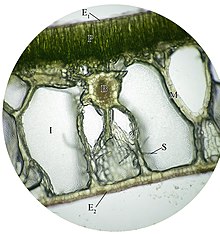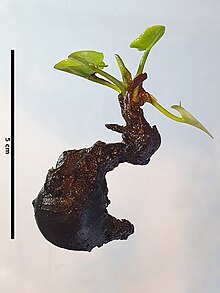Nymphaea
65 species, see text[1] Nymphaea (/nɪmˈfiːə/) is a genus of hardy and tender aquatic plants in the family Nymphaeaceae.
[3] Water lilies are aquatic, rhizomatous or tuberous, perennial or annual herbs[6] with sometimes desiccation-tolerant,[7] branched or unbranched rhizomes,[8][3] which can be stoloniferous, or lacking stolons.
[16] The diurnal or nocturnal,[3] chasmogamous or rarely cleistogamous,[9] solitary, hermaphrodite, entomophilous,[6] fragrant or inodorous flowers[17] are mostly protogynous.
[17] The flowers have (3–)4(–5)[6] green, sometimes spotted sepals,[13] and about 6–50[6] lanceolate to spathulate, differently coloured petals,[13] which are often gradually transitioning into the shape of the stamens.
[37][38] Likewise, beetle pollination by Ruteloryctes morio, a member of the same Cyclocephalini tribe, has been reported in Nymphaea subg.
[44][45][46] It has been proposed to employ the weevil species Bagous longulus as a biocontrol agent against Nymphaea mexicana in South Africa.
[53] Water lilies are not only decorative, but also provide useful shade which helps reduce the growth of algae in ponds and lakes.
These cultivars have gained the Royal Horticultural Society's Award of Garden Merit: All water lilies are poisonous and contain an alkaloid called nupharin in almost all of their parts.
[62] In Sri Lanka it was formerly eaten as a type of medicine and its price was too high to serve as a normal meal, but in the 1940s or earlier some villagers began to grow water lilies in the paddy fields left uncultivated during the monsoon season (Yala season), and the price dropped.
[62] In West Africa, usage varied between cultures, in the Upper Guinea the rhizomes were only considered famine foods - here the tubers were either roasted in ashes, or dried and ground into a flour.
[65] Water lilies were said to have been a major food source for a certain tribe of indigenous Australians in 1930, with the flowers and stems eaten raw, while the "roots and seedpods" were cooked either on an open fire or in a ground oven.
[67] A Roman belief existed that drinking a liquid of crushed Nymphaea in vinegar for 10 consecutive days turned a boy into a eunuch.
[69] A Syrian terra-cotta plaque from the 14th–13th centuries BC shows the goddess Asherah holding two lotus blossoms.
An ivory panel from the 9th-8th centuries BC shows the god Horus seated on a lotus blossom, flanked by two cherubs.
[70] The French Impressionist painter Claude Monet is known for his many paintings of water lilies in the pond in his garden at Giverny.
According to one source, this topic "was the subject of a lecture by William Emboden given at Nash Hall of the Harvard Botanical Museum on the morning of April 6, 1979".

- E1: upper epiderm
- E2: lower epiderm
- P: palisade mesophyll
- M: spongy mesophyll
- B: vascular bundle
- I: intercellular gap
- S: sclerenchyma






S = sepals, P = petals, St = stamina, An = anthers, O = ovary, SD = stigma disc, CT = carpellary teeth


Upper surface (left) and lower surface (right)



